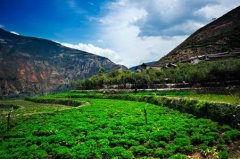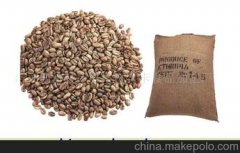A brief introduction to the History and Culture of the Origin and Development of Yunnan small Coffee Huaguoshan Coffee

In addition, although the environmental problems of coffee cultivation can meet the standards of hot areas, they are far away from the equator, evaporation, large-scale coffee cultivation in Yunnan is less than 1100m above sea level, the severe drought in Yunnan in recent years, and the frost period in the producing areas, and so on, all make the cultivation of coffee can not be guaranteed normally, directly affecting the quality of coffee production. As for other processing problems, not to mention the quality of farmers, tea farmers have been drinking tea for generations, but farmers may not have had coffee in their lives.
Say so much, but it doesn't mean that you haven't had a cup of good Yunnan coffee, and if the post-processing and baking is good, as a friend here said, the coffee from several hills, such as Pu'er Man Laojiang, Manzhong Tian Kaddura, Baoshan Lujiang Baihualing Ironpika, Guang Kang bourbon and so on, are still good, especially resistant to the old varieties at an altitude of 1800m.
Coffee cultivation in China is concentrated in Yunnan and Hainan provinces. Dehong in Yunnan has a large output, with an annual output of about 26000 tons in recent years, accounting for 90 per cent of the national output. It is said that small grains of coffee came from the French 70 or 80 years ago. The main variety is Arabica Arabica, the so-called small seed coffee, commonly known as Yunnan Dehong small grain coffee.
Yunnan's high-quality geographical and climatic conditions provide good conditions for the growth of small-grain coffee. The planting areas are Lincang, Baoshan, Simao, Xishuangbanna, Dehong and other prefectures.
Dehong Hougu Coffee Co., Ltd. is better in the Science and Technology Museum, No. 1 Cuihu West Road, Kunming, Yunnan Province.
Small-grain coffee is suitable for growing in the mountains at an altitude of 800 to 1800 meters. If the altitude is too high, it will taste sour, and if it is too low, it will taste bitter. Small grains of coffee are mostly planted in dry and hot valleys about 1100 meters above sea level, so they are moderately sour, rich and mellow. There is a unique environment suitable for the growth of small seed coffee in many areas of Yunnan, and the quality of small seed coffee is excellent.
The planting areas are mainly distributed in Lincang, Baoshan, Simao, Xishuangbanna, Dehong, Nujiang and other states.
The average temperature of Lujiangba in Baoshan is 21.5℃, and the highest is 40.4 ℃, which is basically frost-free all the year round. It is recognized as the best producing area of small-grain coffee. The small-grain coffee cultivated here is famous at home and abroad for its strong but not bitter, fragrant but not strong, well-proportioned small noodles, mellow and fruity.
In recent years, the planting area of small-grain coffee in other producing areas of Yunnan has been expanding, the quality has also made great progress, and the popularity of small-grain coffee has been improved both at home and abroad.
After inspecting the coffee planting and primary processing base in Yunnan, the tasting experts of the International Coffee Organization rated Yunnan coffee as a kind of small seed coffee processed by wet processing in Colombia. Tibeka coffee, the highest quality coffee in the world, originated from Ethiopia and southeastern Sudan, and is the most widely cultivated variety of coffee in the Western Hemisphere. The plant is stronger, but not light-tolerant, and the yield is higher in Hawaii. The top leaf of Tibika is red and copper, which is called red top coffee.
Bourbon coffee is a variety of small-grain coffee second only to Tibica. At first, the main branch and the trunk grew upward at 45 degrees, and drooped with fruit load, the lateral branches were denser, the fruit was more, and the yield was higher. But the berries are smaller and ripen more slowly. The top bud of Bobang is green, which is called green top coffee.
Catimor is an improved variety of Tiebika, with 25% Robusta gene.
Yunnan small-grain coffee, Rubiaceae, coffee genus, the planting area is mainly distributed in Lincang, Baoshan, Simao, Xishuangbanna, Dehong, Nujiang and other states. [1] small grains of coffee are native to Ethiopia or Arabian Peninsula. It is cultivated in Fujian, Guangdong, Hainan, Guangxi, Sichuan, Guizhou and Yunnan. Superior geographical conditions make the coffee industry in Yunnan develop rapidly. In 2014, both planting area and output accounted for more than 99% of the country's total.
The main planting sites are also concentrated in Dehong Lincang and Pu'er Banna in Baoshan, western Yunnan. The coffee introduced by missionaries in the 19th century was mainly Robusta, but it was no longer planted on a large scale. In the 1950s, experts assisted by the Soviet Union brought two mainstream Arabica varieties: iron pickup typica and bourbon bourbon to Baoshan, Yunnan, for cultivation and promotion, which was well received. Later, due to the special period, Scientific research and cultivation tends to stagnate. After the reform and opening up, thanks to the efforts of local agricultural experts, the variety of iron pickup cultivated by Baoshan state-run Lujiang Farm and Xincheng Youth Farm also won the first place in the international coffee competition. However, people's awareness of coffee, so that we do not increase too much interest in planting. Since the early 1990s, in order to improve the enthusiasm of farmers, Baoshan Rezuo has introduced a Katim variety bred by the Portuguese Coffee Rust Research Center with Timor (medium grain, Tim) and Caturra (small grain, Kaddura), and has been popularized and planted with numerous titles. This variety has well solved many factors such as disease and insect disasters and drought resistance, and the important thing is that the yield per mu has nearly doubled. Although it has increased the enthusiasm of farmers to grow coffee, it has also become the reason for the low quality of Yunnan coffee from now on. At the same time, Nestl é and Maxwell entered China and began to promote coffee varieties suitable for instant coffee in Pu'er and other places: S288, natural hybrid of large seed and small seed and S26 of kent hybrid of Arabica Kent in India, which had first-class rust resistance, but the planting difficulty and adaptability were low, and the cultivation was basically stopped at the beginning of the 20th century.
Speaking of which, I think there should be some judgment on the varieties of coffee in Yunnan. What about the excellent iron pickup and bourbon before? In the new promotion and planting, there are still many hills left to continue to grow old varieties of coffee, but, generally speaking, backward places do not have the protection of origin and a single species, a mountain, 10 families, all kinds of people, a gust of wind blowing, pollen flying everywhere. He he. The problem of variety, so that Yunnan coffee really lost in the starting line.
Important Notice :
前街咖啡 FrontStreet Coffee has moved to new addredd:
FrontStreet Coffee Address: 315,Donghua East Road,GuangZhou
Tel:020 38364473
- Prev

Brief introduction of Yunnan small Coffee Huaguoshan Coffee Flavor, taste and aroma characteristics
Dehong: it is known as the hometown of coffee in China. As of 2011, a total of 120900 mu of coffee has been developed and planted in the state, accounting for 30% of the total coffee planting area in the country. In the next 3 years, the planting area of coffee in Dehong Prefecture will reach 200000 mu. Coffee plants in Dehong Prefecture are all above 1000 meters above sea level, of which 30, 000 mu are planted in mountains above 1600 meters above sea level, plus coffee is grown in Dehong Prefecture.
- Next

A brief introduction to the Market Price of Yunnan small Coffee Huaguoshan Coffee Variety planting
1) add an appropriate amount of pure water to the lower seat of the siphon kettle (heated pure water can be used to shorten the time of boiling water. In this operation, the amount of water added is 2.5 cups, that is, about 280 milliliters, two cups of water is for guests / friends, the extra half of the cup is for the brewers to taste in advance, if the taste is abnormal, do not give it to the guests, hehe); 2) in the alcohol lamp
Related
- Detailed explanation of Jadeite planting Land in Panamanian Jadeite Manor introduction to the grading system of Jadeite competitive bidding, Red bid, Green bid and Rose Summer
- Story of Coffee planting in Brenka region of Costa Rica Stonehenge Manor anaerobic heavy honey treatment of flavor mouth
- What's on the barrel of Blue Mountain Coffee beans?
- Can American coffee also pull flowers? How to use hot American style to pull out a good-looking pattern?
- Can you make a cold extract with coffee beans? What is the right proportion for cold-extracted coffee formula?
- Indonesian PWN Gold Mandrine Coffee Origin Features Flavor How to Chong? Mandolin coffee is American.
- A brief introduction to the flavor characteristics of Brazilian yellow bourbon coffee beans
- What is the effect of different water quality on the flavor of cold-extracted coffee? What kind of water is best for brewing coffee?
- Why do you think of Rose Summer whenever you mention Panamanian coffee?
- Introduction to the characteristics of authentic blue mountain coffee bean producing areas? What is the CIB Coffee Authority in Jamaica?

